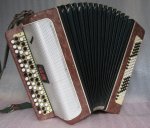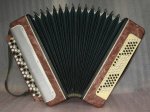Colored buttons may be useful for very early beginners especially when one plays in front of mirror. These instruments with colored bass buttons were made for beginners and self leaners. I have seen many old and new self instruction books for bayan and they all contain both keyboard layouts with colored buttons. It is good visual feedback also for teacher.
Illustrative example:
Lets suppose that I am interensted in CBA but dont know anything abot music theory and nothing about how accordion bass keyboard works. What I do? I dont have teacher also. I have only instrument and instruction book. I start with book and look my instrument, I notice that book has exactly same layouts that my instrument has, so far so good. First chapter explains something about how to read sheet music and at the ond of chapter there are couple lines of music. But I dont know which buttons correspond to which notes? No problem, I take seat in front of mirror and open keyboard layout page.
One hour later - Yay, I have played these couple lines of music, now I move on to bass side... what it isnt same keyboard at all? Some buttons sound like single notes and some sound like bunch of notes no logic at all. Happily bass side keyboard layout is in book, these fancy colored buttons on my instrument realy help me to orient in this unlogical system.
Two hours later - Look everybody, I can slowly play simple two chord tune.
Two weeks later - I understand a little how bass keyboard works, but still need sometimes to play in front of mirror when working out tunes with bass jumps.
Couple months later - I just finished chapter about intervals and chords, now I know how to find notes on my bass side if I dont know where they are located... finally!
So I think colored bass buttons are not pointless entirely. With professional teacher they are probably not necessary but for self leaners they may speed things up a little. And guess what Tyla factory still makes instruments with colored bass buttons
http://melodia-tula.com/c1_0005.htm
I started with PA and with single colored bass buttons, but my beginning was easyer thanks to granddad who played accordion. Otherwise it may have been probably quite hard. Later I went into childrens music school and life went much easyer there also.


